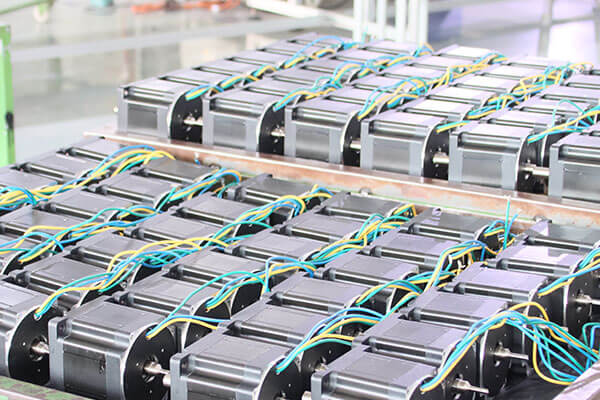
A Brushless dc motors (BLDC Motor: Brushless Direct Current Motor) is a 3-phase motor whose rotation is driven by the forces of attraction and repulsion between permanent magnets and electromagnets. It is a synchronous motor that uses direct current (DC) power. This motor type is often called a "brushless DC motor" because in many applications it uses brushes instead of a DC motor (brushed DC motor or commutator motor). The brushless DC motor is essentially a permanent magnet synchronous motor that uses DC power input and uses an inverter to convert it into a three-phase AC power supply with position feedback.

A Brushless dc motor (BLDC) operates using the Hall effect and is made up of several key components: a rotor, a stator, a permanent magnet, and a drive motor controller. The rotor features multiple steel cores and windings attached to the rotor shaft. As the rotor spins, the controller uses a current sensor to determine its position, allowing it to adjust the direction and strength of the current flowing through the stator windings. This process effectively generates torque.
In conjunction with an electronic drive controller that manages the brushless operation and converts the supplied DC power into AC power, BLDC motors can deliver performance similar to that of brushed DC motors, but without the limitations of brushes, which wear out over time. Because of this, BLDC motors are often referred to as electronically commutated (EC) motors, distinguishing them from traditional motors that rely on mechanical commutation with brushes.
Common Motor Type
Motors can be categorized based on their power supply (either AC or DC) and the mechanism they employ to generate rotation. Below, we provide a brief overview of the characteristics and applications of each type.
What is a Brushed DC Motor? A Comprehensive Guide
Brushed DC motors have long been a staple in the world of electrical engineering. Known for their simplicity, reliability, and cost-effectiveness, these motors are widely used in numerous applications ranging from household appliances to industrial machinery. In this article, we will provide a detailed overview of brushed DC motors, exploring their operation, components, advantages, disadvantages, and common uses, as well as a comparison to their brushless counterparts.
Understanding the Basics of Brushed DC Motors
A brushed DC motor is a type of direct current (DC) electric motor that relies on mechanical brushes to deliver current to the motor windings. The basic principle behind the motor's operation involves the interaction between a magnetic field and an electric current, generating a rotational force known as torque.
How Do Brushed DC Motors Work?
In a brushed DC motor, an electric current flows through a set of windings (or armature) located on the rotor. As the current flows through the windings, it interacts with the magnetic field produced by permanent magnets or field coils. This interaction creates a force that causes the armature to rotate.
The commutator is a key component in a brushed DC motor. It is a rotating switch that reverses the direction of the current flow through the armature windings as the motor turns. This ensures that the armature continues to rotate in the same direction, providing consistent motion.
Key Components of a Brushed DC Motor
Armature (Rotor): The rotating part of the motor that contains the windings and interacts with the magnetic field.
Commutator: A mechanical switch that ensures the current flow is reversed in the windings as the motor rotates.
Brushes: Carbon or graphite brushes that maintain electrical contact with the commutator, enabling the current to flow into the armature.
Stator: The stationary part of the motor, typically consisting of permanent magnets or electromagnets that create the magnetic field.
Shaft: The central rod connected to the armature that transmits the rotational force to the load.
Brushed DC motors remain an essential technology in many industries due to their simplicity, reliability, and cost-effectiveness. While they do have limitations, such as brush wear and reduced efficiency at high speeds, their advantages—such as high starting torque and ease of control—ensure their continued relevance in a variety of applications. Whether in household appliances, power tools, or small robotics, brushed DC motors offer a proven solution for tasks that require moderate power and precise control.
What is a Stepper Motor? A Complete Guide
Stepper motors are a type of DC motor known for their ability to move in precise steps or increments, making them ideal for applications that require controlled movement. Unlike conventional motors, which rotate continuously when powered, a stepper motor divides a full rotation into a number of discrete steps, each of which is a precise fraction of the complete rotation. This capability makes them valuable for a wide range of applications in industries like robotics, 3D printing, automation, and more.
In this article, we will explore the fundamentals of stepper motors, their working principles, types, advantages, disadvantages, applications, and how they compare to other motor technologies.
How Does a Stepper Motor Work?
A stepper motor operates on the principle of electromagnetism. It has a rotor (the moving part) and a stator (the stationary part), similar to other types of electric motors. However, what sets a stepper motor apart is how the stator energizes its coils to make the rotor turn in discrete steps.
Basic Working Principle
When current flows through the stator's coils, it generates a magnetic field that interacts with the rotor, causing it to rotate. The rotor is typically made of a permanent magnet or a magnetic material, and it moves in small increments (steps) as the current through each coil is switched on and off in a specific sequence.
Each step corresponds to a small rotation, typically ranging from 0.9° to 1.8° per step, though other step angles are possible. By energizing different coils in a precise order, the motor is able to achieve fine, controlled motion.
Step Angles and Precision
The resolution of a stepper motor is defined by the step angle. For example, a stepper motor with a 1.8° step angle will complete one full rotation (360°) in 200 steps. Smaller step angles, like 0.9°, allow for even finer control, with 400 steps to complete a full rotation. The smaller the step angle, the greater the precision of the motor’s movement.
Types of Stepper Motors
Stepper motors come in several varieties, each designed to suit specific applications. The main types are:
1. Permanent Magnet Stepper (PM Stepper)
A Permanent Magnet Stepper motor uses a permanent magnet rotor and operates in a manner similar to a DC motor. The rotor’s magnetic field is attracted to the stator’s magnetic field, and the rotor steps to align with each energized coil.
Advantages: Simple design, low cost, and moderate torque at low speeds.
Applications: Basic positioning tasks like in printers or scanners.
2. Variable Reluctance Stepper (VR Stepper)
In a Variable Reluctance Stepper motor, the rotor is made of a soft iron core, and the rotor does not have permanent magnets. The rotor moves to minimize the reluctance (resistance) to magnetic flux. As the current in the coils is switched, the rotor moves toward the most magnetic area, step by step.
3. Hybrid Stepper Motor
A Hybrid Stepper Motor combines the features of both permanent magnet and variable reluctance stepper motors. It has a rotor that is made of permanent magnets but also contains soft iron elements that improve performance and provide better torque output. Hybrid motors offer the best of both worlds: high torque and precise control.
Advantages: Higher efficiency, more torque, and better performance than PM or VR types.
Applications: Robotics, CNC machinery, 3D printers, and automation systems.
Stepper motors are essential components in systems that require accurate positioning, speed control, and torque at low speeds. With their ability to move in precise increments, they excel in applications like 3D printing, robotics, CNC machines, and more. Although they have some limitations, such as reduced efficiency at higher speeds and vibration at low speeds, their reliability, precision, and ease of control make them indispensable in numerous industries.
If you're considering a stepper motor for your next project, it's important to assess your needs and the specific advantages and disadvantages to determine whether a stepper motor is the right choice for your application.
What is an Induction Motor? A Comprehensive Overview
An induction motor is a type of electric motor that operates based on the principle of electromagnetic induction. It's one of the most commonly used motors in industrial and commercial applications due to its simplicity, durability, and cost-effectiveness. In this article, we’ll dive into the working principle of induction motors, their types, advantages, disadvantages, and common applications, as well as a comparison with other motor types.
How Does an Induction Motor Work?
The induction motor operates on the principle of electromagnetic induction, discovered by Michael Faraday. In essence, when a conductor is placed within a changing magnetic field, an electrical current is induced in the conductor. This is the fundamental principle behind the operation of all induction motors.
Key Components of an Induction Motor
An induction motor typically consists of two main parts:
Stator: The stationary part of the motor, usually made of laminated steel, containing coils that are energized by alternating current (AC). The stator generates a rotating magnetic field when AC is passed through the coils.
Rotor: The rotating part of the motor, placed inside the stator, which can either be a squirrel cage rotor (most common) or a wound rotor. The rotor is induced to rotate by the magnetic field produced by the stator.
The Basic Working Principle
When AC power is supplied to the stator, it generates a rotating magnetic field.
This rotating magnetic field induces an electrical current in the rotor due to electromagnetic induction.
The induced current in the rotor generates its own magnetic field, which interacts with the stator's magnetic field.
As a result of this interaction, the rotor starts to rotate, creating mechanical output. The rotor must always "chase" the rotating magnetic field produced by the stator, which is why it's called an induction motor—because the current in the rotor is "induced" by the magnetic field rather than directly supplied.
Slip in Induction Motors
A unique feature of induction motors is that the rotor never actually reaches the same speed as the magnetic field in the stator. The difference between the speed of the stator’s magnetic field and the rotor’s actual speed is known as slip. The slip is necessary to induce the current in the rotor, which is what generates torque.
Types of Induction Motors
Induction motors come in two main types:
1. Squirrel Cage Induction Motor
This is the most commonly used type of induction motor. The rotor consists of laminated steel with conducting bars arranged in a closed loop. The rotor resembles a squirrel cage, and because of this construction, it is simple, rugged, and reliable.
Advantages:
Applications: Used in most industrial and commercial applications, including pumps, fans, compressors, and conveyors.
2. Wound Rotor Induction Motor
In this type, the rotor consists of windings (instead of short-circuited bars) and is connected to external resistance. This allows for more control over the motor’s speed and torque, making it useful in certain specific applications.
Advantages:
Applications: Used in applications requiring high starting torque or where variable speed control is needed, such as cranes, elevators, and large machinery.
What is a Synchronous Motor? A Detailed Overview
A synchronous motor is a type of AC motor that operates at a constant speed, called synchronous speed, regardless of the load on the motor. This means that the rotor of the motor rotates at the same speed as the rotating magnetic field produced by the stator. Unlike other motors, such as induction motors, a synchronous motor requires an external mechanism to start, but it can maintain synchronous speed once running.
In this article, we’ll explore the working principle of synchronous motors, their types, advantages, disadvantages, applications, and how they differ from other motor types like induction motors.
How Does a Synchronous Motor Work?
The basic operation of a synchronous motor involves the interaction between the rotating magnetic field produced by the stator and the magnetic field created by the rotor. The rotor, unlike in induction motors, is typically equipped with permanent magnets or electromagnets powered by direct current (DC).
Key Components of a Synchronous Motor
A typical synchronous motor consists of two primary components:
Stator: The stationary part of the motor, which is usually composed of windings that are powered by AC supply. The stator generates a rotating magnetic field when AC current flows through the windings.
Rotor: The rotating part of the motor, which can be either a permanent magnet or electromagnetic rotor powered by a DC supply. The rotor’s magnetic field locks in with the rotating magnetic field of the stator, causing the rotor to turn at synchronous speed.
The Basic Working Principle
When AC power is applied to the stator windings, a rotating magnetic field is generated.
The rotor, with its magnetic field, locks into this rotating magnetic field, meaning the rotor follows the stator’s magnetic field.
As the magnetic fields interact, the rotor synchronizes with the rotating field of the stator, and both rotate at the same speed. This is why it’s called a synchronous motor — the rotor runs in sync with the frequency of the AC supply.
Since the rotor’s speed matches the stator’s magnetic field, synchronous motors operate at a fixed speed determined by the frequency of the AC supply and the number of poles in the motor.
Types of Synchronous Motors
Synchronous motors come in several different configurations, depending on the rotor design and the application.
1. Permanent Magnet Synchronous Motor (PMSM)
In a permanent magnet synchronous motor, the rotor is equipped with permanent magnets, which provide the magnetic field for synchronization with the stator’s rotating magnetic field.
Advantages: High efficiency, compact design, and high torque density.
Applications: Used in applications where precise speed control is required, such as electric vehicles and high-precision machinery.
2. Wound Rotor Synchronous Motor
A wound rotor synchronous motor uses a rotor that is wound with copper windings, which are energized by a DC supply through slip rings. The rotor windings produce the magnetic field needed for synchronization with the stator.
Advantages: More robust than permanent magnet motors and capable of withstanding higher power levels.
Applications: Used in large industrial systems where high power and torque are needed, such as generators and power plants.
3. Hysteresis Synchronous Motor
A hysteresis synchronous motor uses a rotor with magnetic materials that exhibit hysteresis (the lag between the magnetization and the applied field). This type of motor is known for its smooth and quiet operation.
Advantages: Extremely low vibration and noise.
Applications: Common in clocks, synchronizing devices, and other low-torque applications where smooth operation is required.
Synchronous motors are powerful, efficient, and precise machines that offer consistent performance in applications requiring constant speed and power factor correction. They are particularly beneficial in large industrial systems, power generation, and applications where precise synchronization is crucial. However, their complexity, higher initial cost, and need for external starting mechanisms make them less suitable for certain applications compared to other motor types like induction motors.
Brushless DC Motor Mechanism
Brushless dc motors operate using two main components: a rotor that contains permanent magnets and a stator equipped with copper coils that become electromagnets when current flows through them.
These motors are classified into two types: inrunner (internal rotor motors) and outrunner (external rotor motors). In inrunner motors, the stator is positioned externally while the rotor rotates inside. Conversely, in outrunner motors, the rotor spins outside the stator. When current is supplied to the stator coils, they generate an electromagnet with distinct north and south poles. When the polarity of this electromagnet aligns with that of the facing permanent magnet, the like poles repel each other, causing the rotor to spin. However, if the current remains constant in this configuration, the rotor will rotate momentarily and then halt as the opposing electromagnets and permanent magnets align. To maintain continuous rotation, the current is supplied as a three-phase signal, which regularly alters the polarity of the electromagnet.
The rotation speed of the motor corresponds to the frequency of the three-phase signal. Therefore, to achieve faster rotation, one can increase the signal frequency. In the context of a remote control vehicle, accelerating the vehicle by increasing the throttle effectively instructs the controller to raise the switching frequency.
How Does Brushless DC Motor Work?
A Brushless dc motor, often referred to as a permanent magnet synchronous motor, is an electric motor known for its high efficiency, compact size, low noise, and long lifespan. It finds extensive applications in both industrial manufacturing and consumer products.
The operation of a brushless DC motor is based on the interplay between electricity and magnetism. It comprises components such as permanent magnets, a rotor, a stator, and an electronic speed controller. The permanent magnets serve as the primary source of the magnetic field in the motor, typically utilizing rare earth materials. When the motor is powered, these permanent magnets create a stable magnetic field that interacts with the current flowing within the motor, generating a rotor magnetic field.
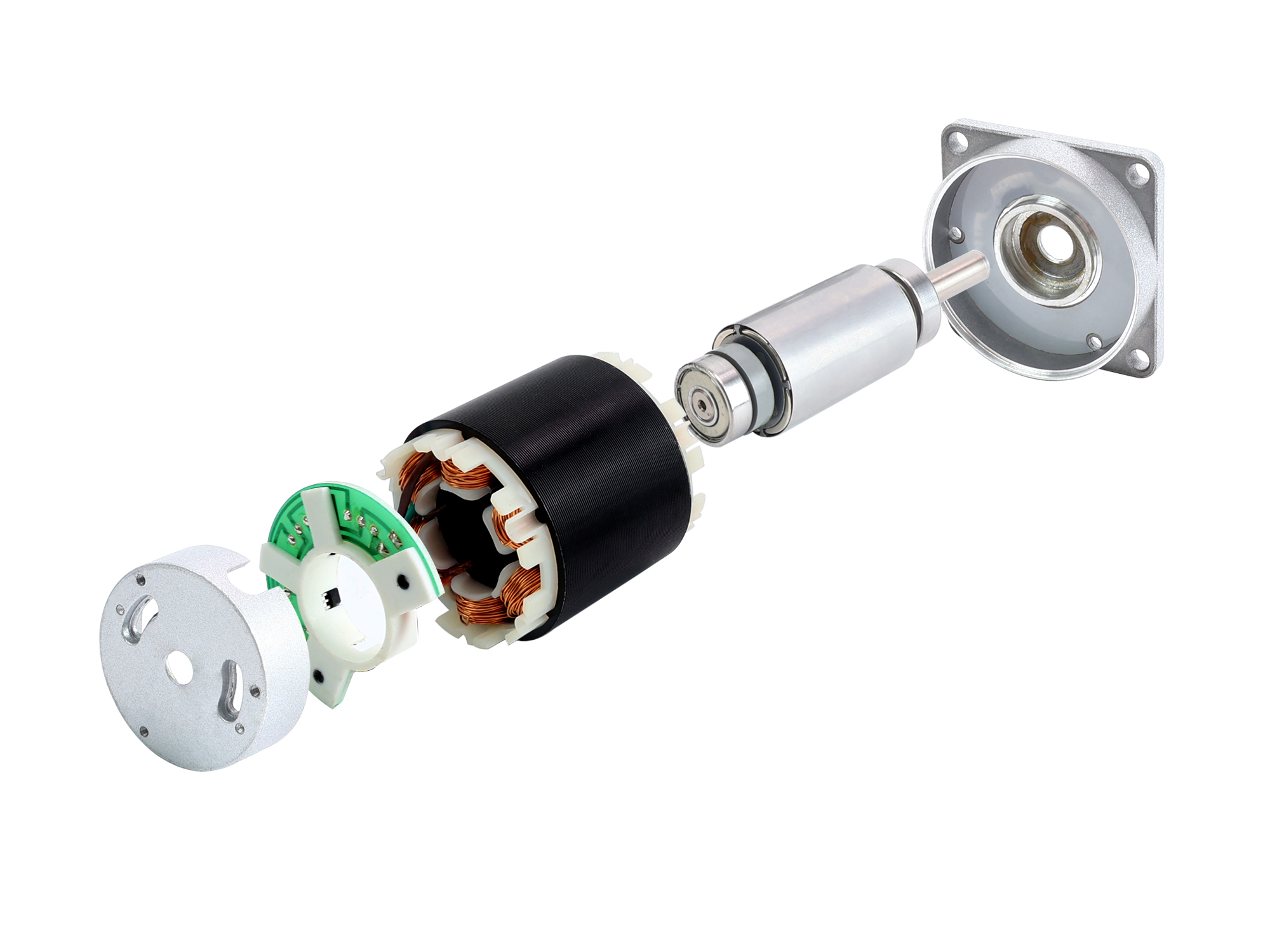
The rotor of a Brushless dc motor is the rotating component and is made up of several permanent magnets. Its magnetic field interacts with the stator's magnetic field, causing it to spin. The stator, on the other hand, is the stationary part of the motor, consisting of copper coils and iron cores. When current flows through the stator coils, it generates a varying magnetic field. According to Faraday's law of electromagnetic induction, this magnetic field influences the rotor, producing rotational torque.
The electronic speed controller (ESC) manages the motor's operational state and regulates its speed by controlling the current supplied to the motor. The ESC adjusts various parameters, including pulse width, voltage, and current, to control the motor's performance.
During operation, current flows through both the stator and rotor, creating an electromagnetic force that interacts with the magnetic field of the permanent magnets. As a result, the motor rotates in accordance with the commands from the electronic speed controller, producing mechanical work that drives the connected equipment or machinery.
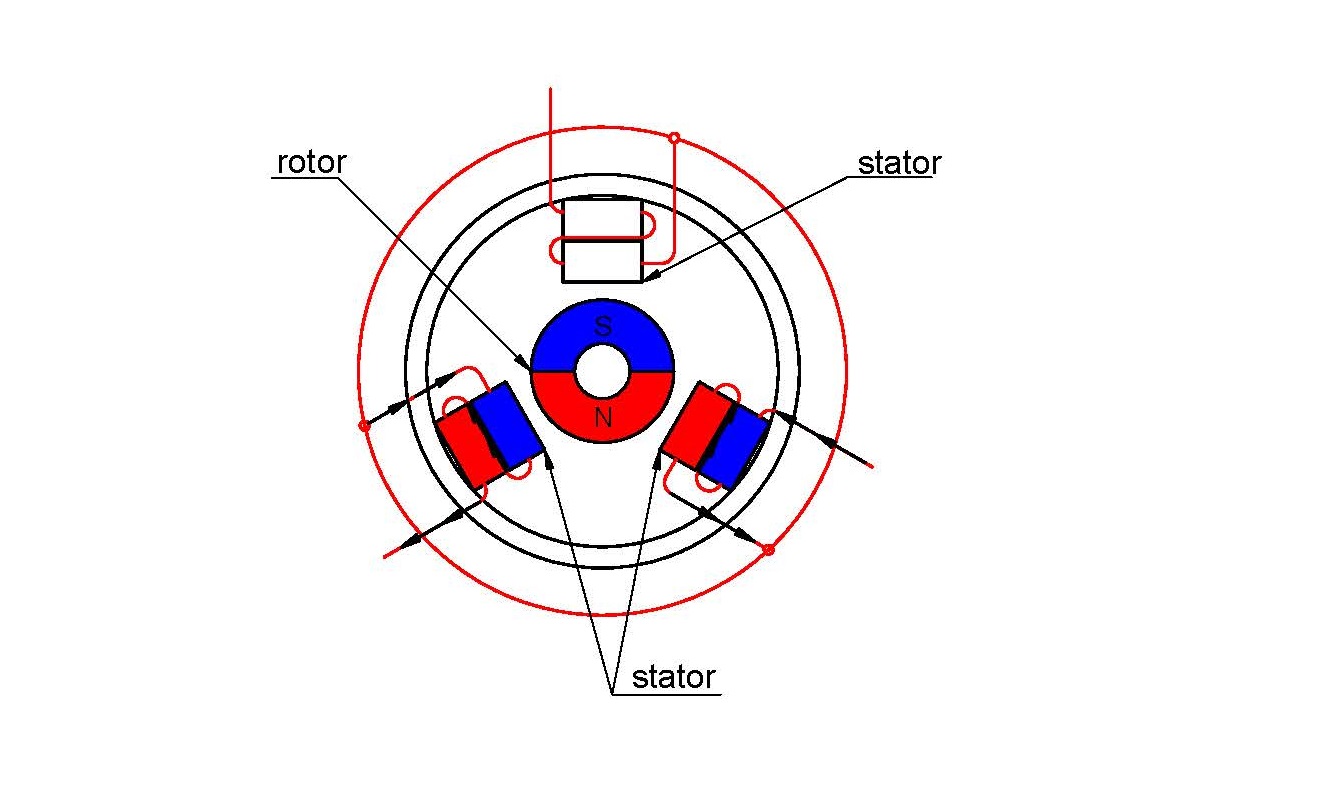
In summary, the Brushless dc motor operates on the principle of electrical and magnetic interactions that produce rotational torque between the rotating permanent magnets and the stator coils. This interaction drives the motor's rotation and converts electrical energy into mechanical energy, allowing it to perform work.
Controlling Brushless DC Motor
To enable a Brushless dc motor to rotate, it is essential to control the direction and timing of the current flowing through its coils. The diagram below illustrates the stator (coils) and rotor (permanent magnets) of a BLDC motor, which features three coils labeled U, V, and W, spaced 120º apart. The motor's operation is driven by managing the phases and currents in these coils. Current flows sequentially through phase U, then phase V, and finally phase W. The rotation is sustained by continuously switching the magnetic flux, which causes the permanent magnets to follow the rotating magnetic field generated by the coils. In essence, the energization of coils U, V, and W must be alternated constantly to keep the resultant magnetic flux in motion, thereby creating a rotating magnetic field that continually attracts the rotor magnets.
There are currently three mainstream brushless motor control methods:
1. Trapezoidal wave control
Trapezoidal wave control, commonly referred to as 120° control or 6-step commutation control, is one of the most straightforward methods for controlling brushless DC (BLDC) motors. This technique involves applying square wave currents to the motor phases, which are synchronized with the trapezoidal back-EMF curve of the BLDC motor to achieve optimal torque generation. BLDC ladder control is well-suited for a variety of motor control system designs across numerous applications, including household appliances, refrigeration compressors, HVAC blowers, condensers, industrial drives, pumps, and robotics.
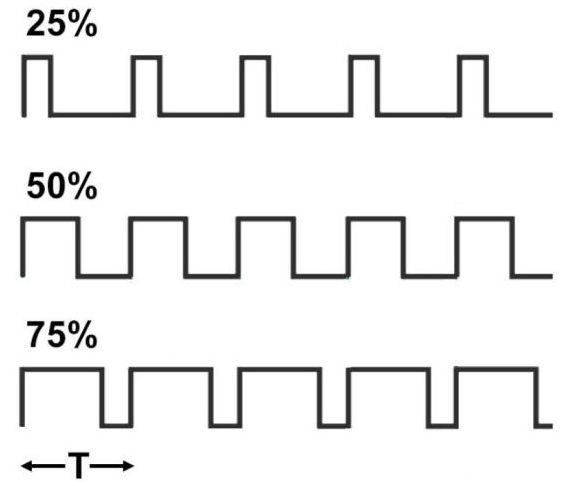
The square wave control method offers several advantages, including a straightforward control algorithm and low hardware costs, allowing for higher motor speeds using a standard performance controller. However, it also has drawbacks, such as significant torque fluctuations, some level of current noise, and efficiency that does not reach its maximum potential. Trapezoidal wave control is particularly suitable for applications where high rotational performance is not required. This method utilizes a Hall sensor or a non-inductive estimation algorithm to determine the rotor's position and executes six commutations (one every 60°) within a 360° electrical cycle based on that position. Each commutation generates force in a specific direction, resulting in an effective positional accuracy of 60° in electrical terms. The name "trapezoidal wave control" comes from the fact that the phase current waveform resembles a trapezoidal shape.
2. Sine Wave Control
The sine wave control method employs Space Vector Pulse Width Modulation (SVPWM) to produce a three-phase sine wave voltage, with the corresponding current also being a sine wave. Unlike square wave control, this approach does not involve discrete commutation steps; instead, it is treated as if an infinite number of commutations occur within each electrical cycle.
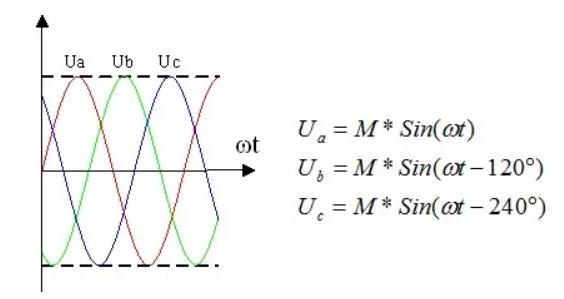
Clearly, sine wave control offers advantages over square wave control, including reduced torque fluctuations and fewer current harmonics, resulting in a more refined control experience. However, it does require slightly more advanced performance from the controller compared to square wave control, and it still does not achieve maximum motor efficiency.
3. Field-Oriented Control (FOC)
Field-Oriented Control (FOC), also referred to as vector control (VC), is one of the most effective methods for efficiently managing Brushless dc motors (BLDC) and permanent magnet synchronous motors (PMSM). While sine wave control manages the voltage vector and indirectly controls the current magnitude, it does not have the capability to control the direction of the current.
.png)
The FOC control method can be viewed as an enhanced version of sine wave control, as it allows for the control of the current vector, effectively managing the vector control of the motor's stator magnetic field. By controlling the direction of the stator magnetic field, it ensures that the stator and rotor magnetic fields remain at a 90° angle at all times, which maximizes torque output for a given current.
4. Sensorless Control
In contrast to conventional motor control methods that rely on sensors, sensorless control enables the motor to operate without sensors such as Hall sensors or encoders. This approach utilizes the motor's current and voltage data to ascertain the rotor's position. The motor speed is then calculated based on changes in rotor position, using this information to regulate the motor's speed effectively.
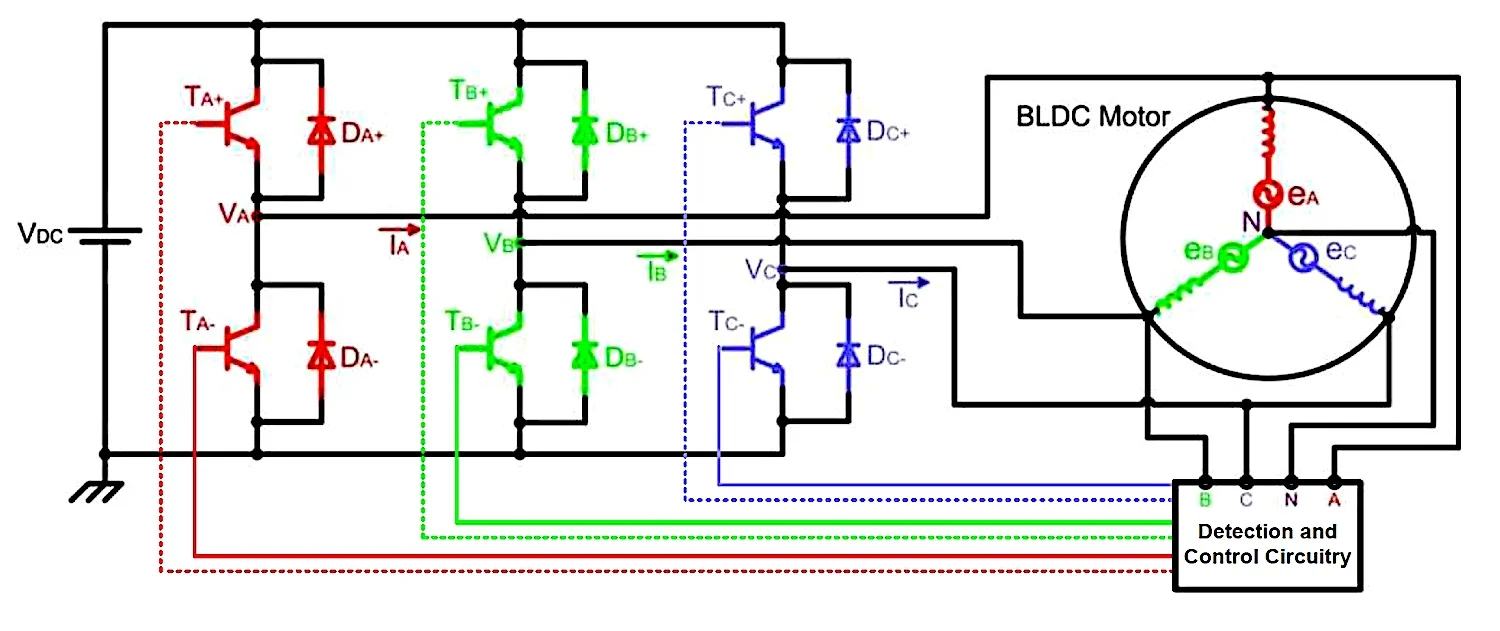
The primary advantage of sensorless control is that it eliminates the need for sensors, allowing for reliable operation in challenging environments. It is also cost-effective, requiring only three pins and taking up minimal space. Additionally, the absence of Hall sensors enhances the system's lifespan and reliability, as there are no components that can be damaged. However, a notable drawback is that it does not provide smooth starting. At low speeds or when the rotor is stationary, the back electromotive force is insufficient, making it difficult to detect the zero-crossing point.
DC Brushed vs. Brushless Motors
Similarities Between DC Brushed and Brushless Motors
Brushless dc motors and brushed DC motors share certain common characteristics and operational principles:
Both brushless and brushed DC motors have a similar structure, comprising a stator and a rotor. The stator produces a magnetic field, while the rotor generates torque through its interaction with this magnetic field, effectively transforming electrical energy into mechanical energy.
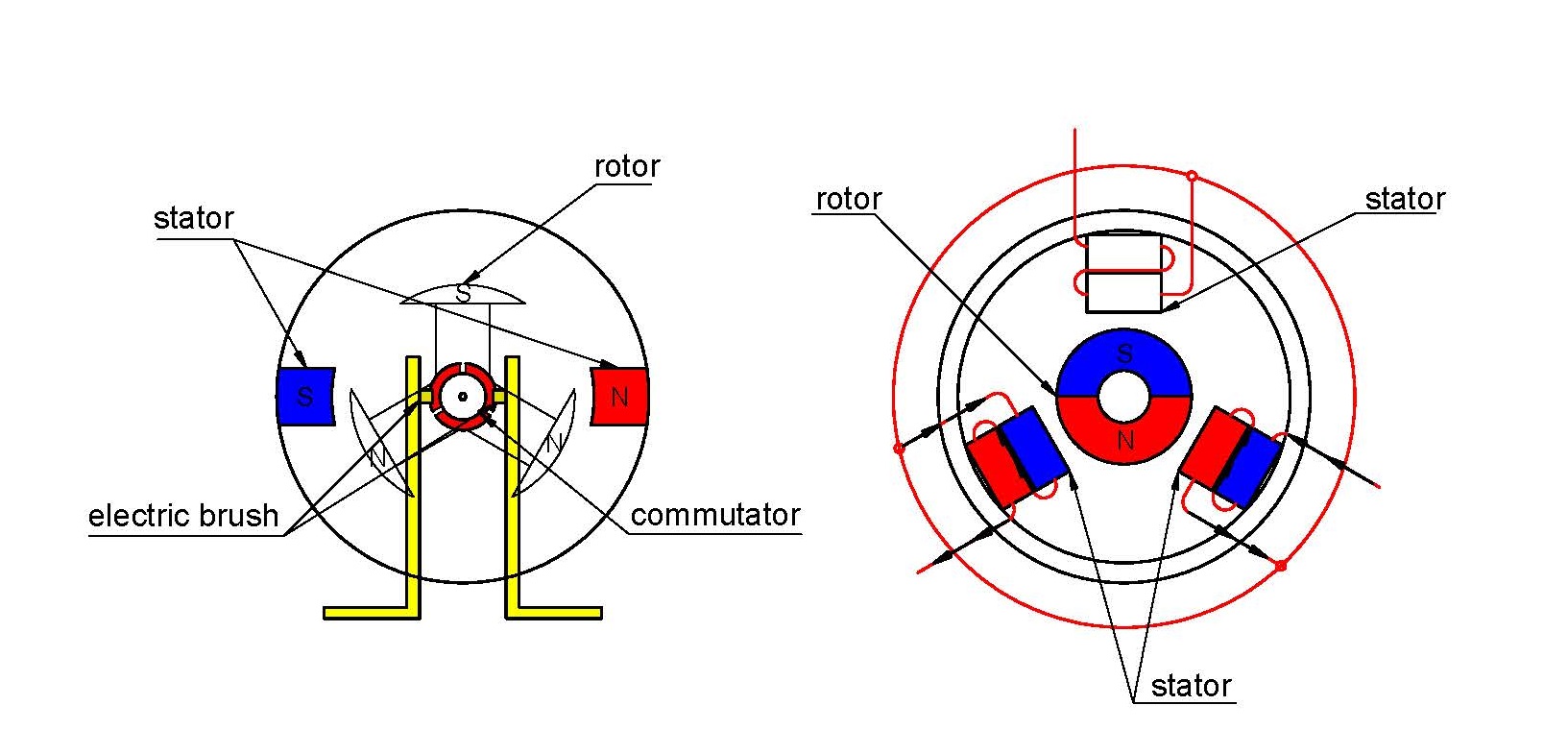
Both Brushless dc motors and brushed DC motors require a DC power supply to provide electrical energy, as their operation relies on direct current.
Both types of motors can adjust speed and torque by altering the input voltage or current, allowing for flexibility and control in various application scenarios.
Differences Between Brushed and Brushless DC Motors
While brushed and Brushless dc motors share certain similarities, they also exhibit significant differences in terms of performance and advantages. Brushed DC motors utilize brushes to commutate the motor's direction, enabling rotation. In contrast, brushless motors employ electronic control to replace the mechanical commutation process.
Brushless DC Motor Type
BesFoc BLDC Motor Type
There are many types of brushless DC motor sold by Jkongmotor, and understanding the characteristics and uses of different types of stepper motors will help you decide which type is best for you.
1. Standard BLDC Motor(Inner Rotor)
BesFoc supplies NEMA 17, 23, 24, 34, 42, 52 frame and metric size 36mm - 130mm standard brushless dc motor. The motors (internal rotor) include 3-phase 12V/24V/36V/48V/72V/110V low voltage and 310V high voltage electric motors with a power range of 10W - 3500W and a speed range of 10rpm - 10000rpm. Integrated Hall sensors can be used in applications that require precise position and speed feedback. While the standard options offer excellent reliability and high performance, most of our motors can also be customized to work with different voltages, powers, speeds, etc. Customized shaft type/length and mounting flanges are available on request.

2. Geared BLDC Motor
A brushless DC geared motor is a motor with a built-in gearbox (including spur gearbox, worm gearbox and planetary gearbox). The gears are connected to the drive shaft of the motor. This picture shows how the gearbox is accommodated in the motor housing.
Gearboxes play a crucial role in lowering the speed of brushless DC motors while enhancing the output torque. Typically, brushless DC motors operate efficiently at speeds ranging from 2000 to 3000 rpm. For instance, when paired with a gearbox that has a 20:1 transmission ratio, the motor's speed can be decreased to around 100 to 150 rpm, resulting in a twentyfold increase in torque.
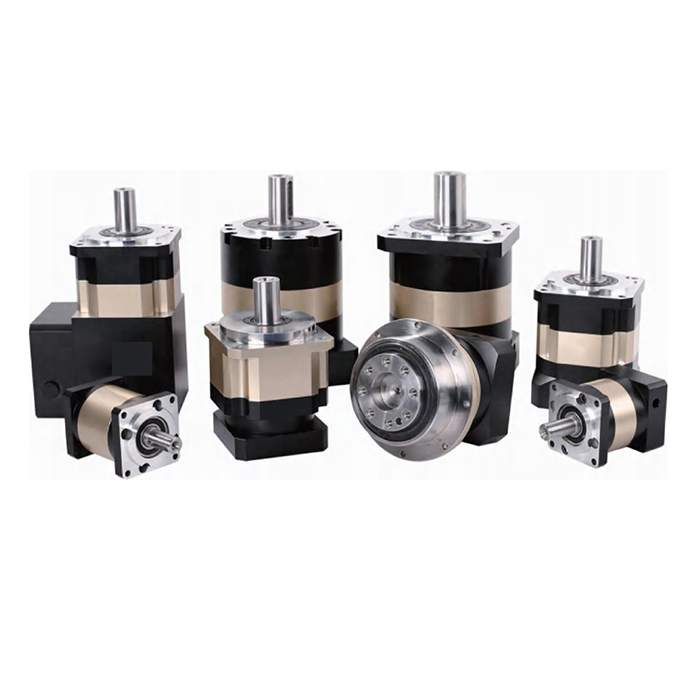
Additionally, integrating the motor and gearbox within a single housing minimizes the external dimensions of geared brushless DC motors, optimizing the use of available machine space.
3. Outer Rotor BLDC Motor
Recent advancements in technology are leading to the development of more powerful cordless outdoor power equipment and tools. A notable innovation in power tools is the external rotor brushless motor design.
Outer rotor Brushless dc motors, or externally powered brushless motors, feature a design that incorporates the rotor on the outside, allowing for smoother operation. These motors can achieve higher torque than similar-sized internal rotor designs. The increased inertia provided by external rotor motors makes them particularly well-suited for applications that require low noise and consistent performance at lower speeds.
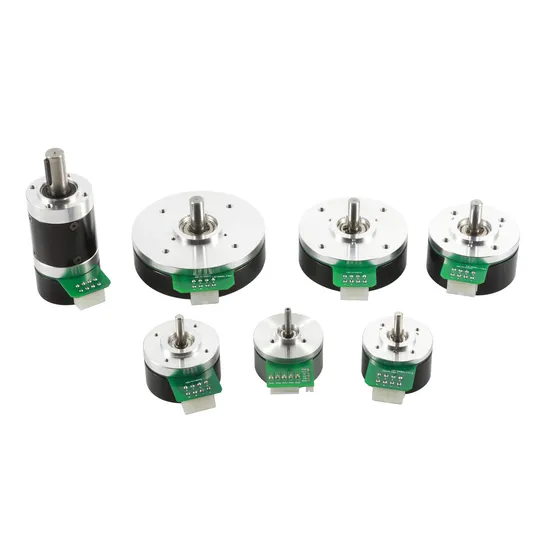
In an outer rotor motor, the rotor is positioned externally, while the stator is situated inside the motor.
Outer-rotor Brushless dc motors are typically shorter than their inner-rotor counterparts, offering a cost-effective solution. In this design, permanent magnets are affixed to a rotor housing that revolves around an inner stator with windings. Due to the higher inertia of the rotor, outer-rotor motors experience lower torque ripple compared to inner-rotor motors.
4. Integrated BLDC Motor
Integrated brushless motors are advanced mechatronic products designed for use in industrial automation and control systems. These motors come equipped with a specialized, high-performance brushless DC motor driver chip, providing numerous advantages, including high integration, compact size, complete protection, straightforward wiring, and enhanced reliability. This series offers a range of integrated motors with power outputs from 100 to 400W. Furthermore, the built-in driver utilizes cutting-edge PWM technology, allowing the brushless motor to operate at high speeds with minimal vibration, low noise, excellent stability, and high dependability. Integrated motors also feature a space-saving design that simplifies wiring and reduces costs compared to traditional separate motor and drive components.
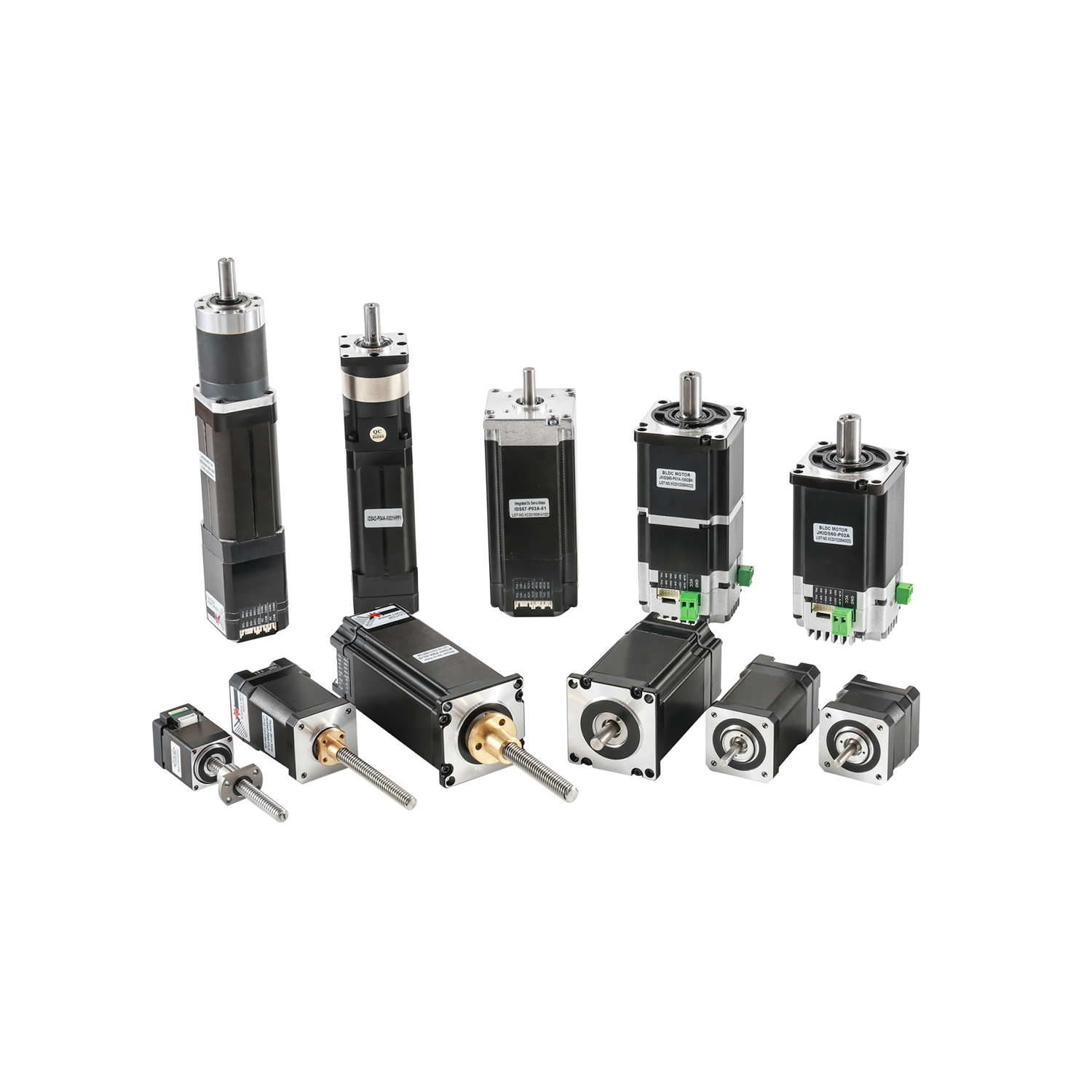
How to Choose Brushless DC Motor Driver
1. Selecting a Suitable Brushless Motor
Begin by choosing a Brushless dc motor based on its electrical parameters. It’s essential to determine key specifications such as the desired speed range, torque, rated voltage, and rated torque before selecting the appropriate brushless motor. Typically, the rated speed for brushless motors is around 3000 RPM, with a recommended operating speed of at least 200 RPM. If prolonged operation at lower speeds is necessary, consider using a gearbox to reduce speed while increasing torque.
Next, select a Brushless dc motor according to its mechanical dimensions. Ensure that the motor's installation dimensions, output shaft dimensions, and overall size are compatible with your equipment. We offer customization options for brushless motors in various sizes based on customer requirements.
2. Choosing the Right Brushless Driver
Select the appropriate driver based on the electrical parameters of the brushless motor. When choosing a driver, confirm that the motor's rated power and voltage fall within the driver’s allowable range to ensure compatibility. Our range of brushless drivers includes low-voltage models (12 - 60 VDC) and high-voltage models (110/220 VAC), tailored for low-voltage and high-voltage brushless motors, respectively. It’s important not to mix these two types.
Additionally, consider the installation size and heat dissipation requirements of the driver to ensure it operates effectively in its environment.
Advantages and Disadvantages of Brushless DC Motors
Advantages
Brushless dc motors (BLDC) offer several benefits compared to other motor types, including compact size, high output power, low vibration, minimal noise, and extended service life. Here are some key advantages of BLDC motors:
Efficiency: BLDC motors can continuously manage maximum torque, unlike brushed motors, which achieve peak torque only at specific points during rotation. Consequently, smaller BLDC motors can generate significant power without the need for larger magnets.
Controllability: These motors can be precisely controlled via feedback mechanisms, allowing for exact torque and speed delivery. This precision enhances energy efficiency, reduces heat generation, and extends battery life in battery-operated applications.
Longevity and Noise Reduction: With no brushes to wear out, BLDC motors have a longer lifespan and produce lower electrical noise. In contrast, brushed motors create sparks during contact between brushes and the commutator, resulting in electrical noise, making BLDC motors preferable in noise-sensitive applications.
Additional advantages include:
Higher efficiency and power density compared to induction motors (approximately 35% reduction in volume and weight for the same output).
Long service life and quiet operation due to precision ball bearings.
A wide speed range and full motor output due to a linear torque curve.
Reduced electrical interference emissions.
Mechanical interchangeability with stepper motors, lowering construction costs and increasing component variety.
Disadvantages
Despite their benefits, brushless motors have some drawbacks. The sophisticated electronics required for brushless drives result in higher overall costs compared to brushed motors.
The Field-Oriented Control (FOC) method, which allows precise control of the magnetic field's size and direction, provides stable torque, low noise, high efficiency, and rapid dynamic response. However, it comes with high hardware costs, stringent performance requirements for the controller, and the need for motor parameters to be closely matched.
Another disadvantage is that brushless motors may experience jitter at startup due to inductive reactance, resulting in less smooth operation compared to brushed motors.
Furthermore, Brushless dc motors necessitate specialized knowledge and equipment for maintenance and repair, making them less accessible to average users.
Uses and Applications of Brushless DC Motors
Brushless DC motors (BLDC) are extensively utilized across various industries, including industrial automation, automotive, medical equipment, and artificial intelligence, due to their longevity, low noise, and high torque.
1. Industrial Automation
In industrial automation, Brushless dc motors are crucial for applications such as servo motors, CNC machine tools, and robotics. They serve as actuators that control the movements of industrial robots for tasks like painting, product assembly, and welding. These applications demand high-precision, high-efficiency motors, which BLDC motors are well-equipped to provide.
2. Electric Vehicles
Brushless dc motors are a significant application in electric vehicles, particularly serving as drive motors. They are especially crucial in functional replacements that demand precise control and in areas where components are frequently utilized, necessitating long-lasting performance. After power steering systems, air conditioning compressor motors represent a primary application for these motors. Furthermore, traction motors for electric vehicles (EVs) also present a promising opportunity for brushless DC motors. Given that these systems operate on limited battery power, it is essential for the motors to be both efficient and compact to accommodate tight space constraints.
Since electric vehicles necessitate motors that are efficient, reliable, and lightweight to deliver power, brushless DC motors, which possess these qualities, are extensively utilized in their drive systems.
3. Aerospace & Drones
In the aerospace sector, Brushless dc motors are among the most commonly employed electric motors due to their exceptional performance, which is crucial in these applications. Modern aerospace technology relies on powerful and efficient brushless DC motors for various auxiliary systems within aircraft. These motors are utilized for controlling flight surfaces and powering systems in the cabin, such as fuel pumps, air pressure pumps, power supply systems, generators, and power distribution equipment. The outstanding performance and high efficiency of brushless DC motors in these roles contribute to the precise control of flight surfaces, ensuring aircraft stability and safety.
In drone technology, Brushless dc motors are utilized to control various systems, including interference systems, communication systems, and cameras. These motors effectively address the challenges of high load and rapid response, delivering high output power and swift responsiveness to ensure the reliability and performance of drones.
4. Medical Equipment
Brushless dc motors are also extensively employed in medical equipment, including devices like artificial hearts and blood pumps. These applications require motors that are high-precision, reliable, and lightweight, all of which are characteristics that brushless DC motors can provide.
As a highly efficient, low-noise, and long-lasting motor, Brushless dc motors are extensively used in the medical equipment sector. Their integration into devices such as medical aspirators, infusion pumps, and surgical beds has enhanced the stability, accuracy, and reliability of these machines, significantly contributing to advancements in medical technology.
5. Smart Home
Within smart home systems, Brushless dc motors are employed in various appliances, including circulating fans, humidifiers, dehumidifiers, air fresheners, heating and cooling fans, hand dryers, smart locks, and electric doors and windows. The shift from induction motors to brushless DC motors and their corresponding controllers in household appliances better satisfies the demands for energy efficiency, environmental sustainability, advanced intelligence, low noise, and user comfort.
Brushless dc motors have been utilized for a long time in consumer electronics, including washing machines, air conditioning systems, and vacuum cleaners. More recently, they have found applications in fans, where their high efficiency has significantly lowered electricity consumption.
In summary, the practical uses of Brushless dc motors are prevalent in everyday life. Brushless DC motors (BLDC) are efficient, durable, and versatile, serving a wide range of applications across different industries. Their design, various types, and applications position them as essential components in contemporary technology and automation.
English
العربية
Français
Русский
Español
Português
Deutsch
italiano
日本語
한국어
Nederlands
Tiếng Việt
ไทย
Polski
Türkçe
ພາສາລາວ
ភាសាខ្មែរ
Bahasa Melayu
ဗမာစာ
Filipino
Bahasa Indonesia
magyar
Română
Čeština
Монгол
қазақ
Српски
हिन्दी
فارسی
Slovenčina
Slovenščina
Norsk
Svenska
українська
Ελληνικά
Suomi
Հայերեն
עברית
Latine
Dansk
Shqip
বাংলা
Hrvatski
Afrikaans
Gaeilge
Eesti keel
Oʻzbekcha
latviešu
Azərbaycan dili
Български
Català







.png)







